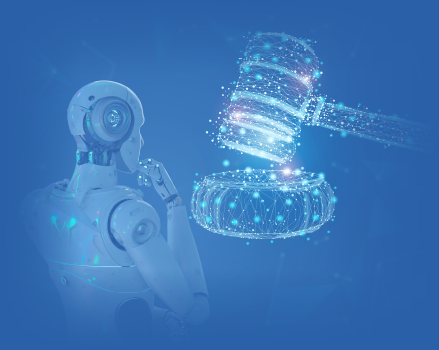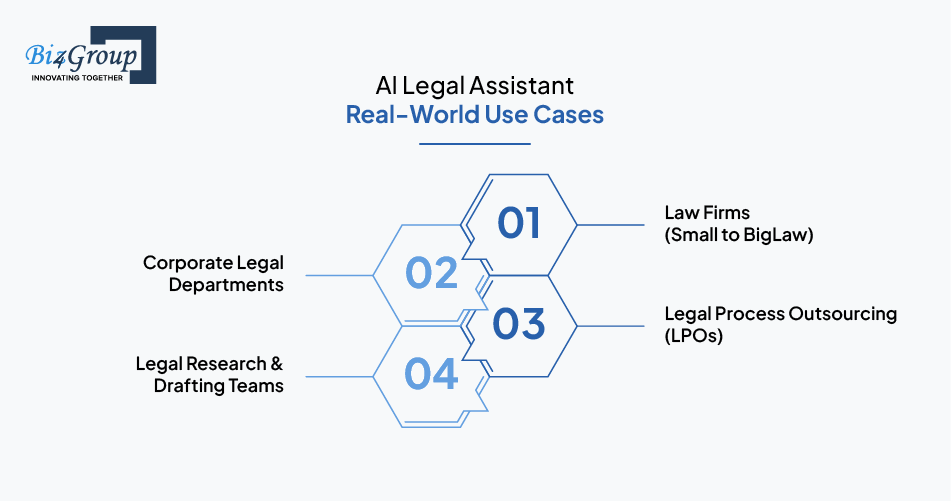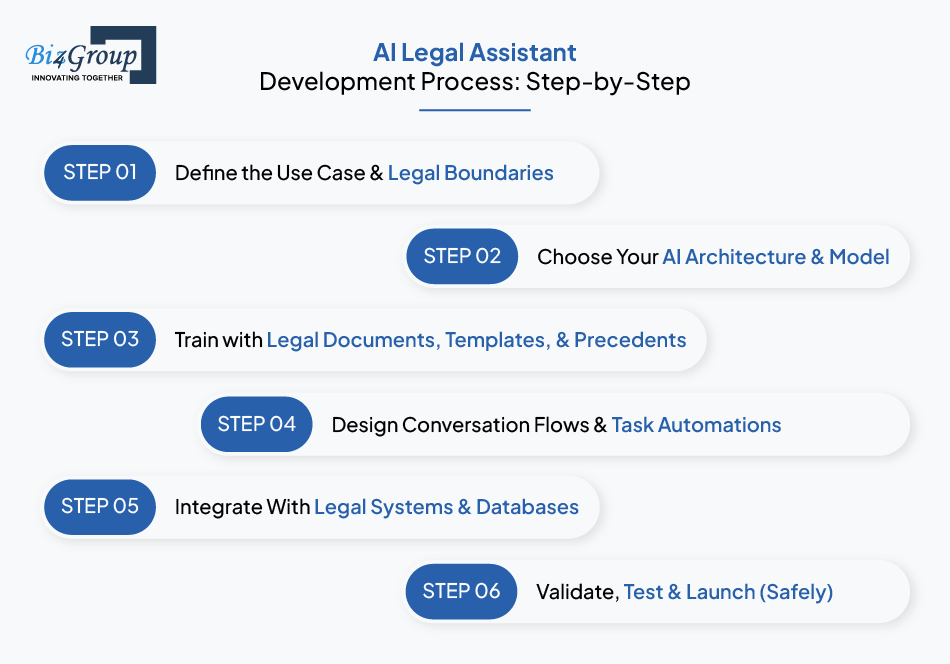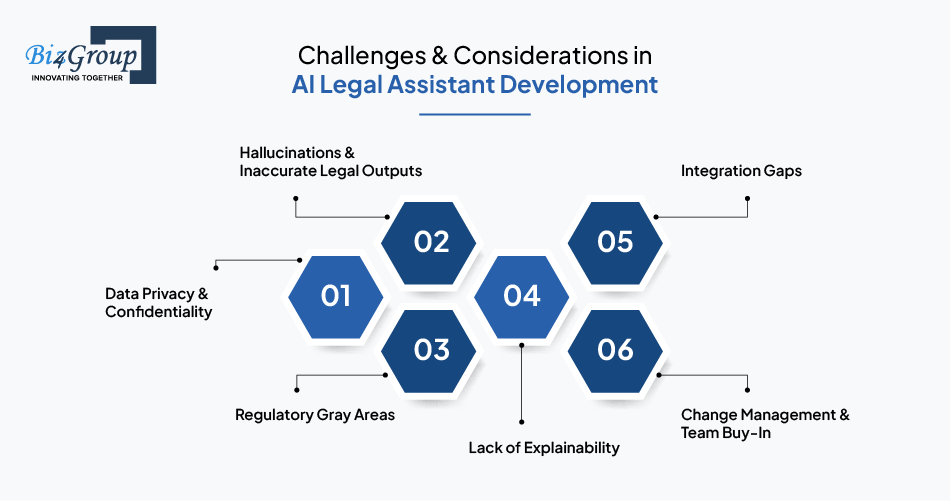Basic AI Chatbot Pricing: A simple chatbot that can answer questions about a product or service might cost around $10,000 to develop.
Read More

AI Legal Assistant Development involves creating intelligent tools that streamline legal workflows, including research, drafting, and client intake.
The cost can range from $10,000 to $150,000+, depending on complexity, compliance needs, and advanced features like RAG and predictive analytics.
Key features include clause suggestions, secure document search, jurisdiction-aware logic, and voice input capabilities.
Biz4Group specializes in compliant, scalable, and domain-aware AI solutions, making us the ideal partner for building high-performance legal assistants.
Your paralegal’s overloaded. Your junior associate’s drowning in discovery. And your inbox is filling with follow-ups you don’t have time to draft.
Now imagine an assistant that never takes lunch, never forgets a deadline, and can summarize a case, draft a contract, and find the right statute — before your first coffee refill.
That’s not a fantasy. It’s what smart firms are building today through AI Legal Assistant Development.
This isn’t your average automation tool that just fills in blanks. We’re talking about AI that understands legal nuance, learns from precedent, and doesn’t need a bar license to be helpful.
Whether you're a solo attorney trying to stay ahead or a corporate legal team buried in compliance requests, these assistants are changing the game — quietly, efficiently, and one automated task at a time.
No surprise: the firms getting it right are partnering with a generative AI development company in USA — not to replace people, but to free them up for the work that actually matters.
An AI legal assistant is more than a digital helper — it’s a trained system that understands legal terminology, follows complex logic, and supports everything from case research to contract drafting. Unlike static tools or rule-based bots, these assistants learn, adapt, and deliver legal insights in real time.
You’re not just automating a checklist — you’re building a system that can parse discovery documents, detect compliance risks, draft clauses, and even summarize multi-jurisdictional cases with contextual relevance.
Whether it’s streamlining intake, reviewing long-form contracts, or auto-filling legal templates, an AI legal assistant app provides a responsive interface for legal teams to interact with powerful backend automation — all in real time.
At its core, this is the difference:
| Functionality | Traditional Assistant | AI-Powered Legal Assistant |
|---|---|---|
|
Document Review |
Manual tagging and search |
AI-powered summarization & context extraction |
|
Legal Research |
Uses search operators |
Delivers relevant cases with reasoning |
|
Drafting Contracts |
Based on templates |
Generates tailored clauses in real time |
|
Workflow Automation |
Rule-based |
Context-aware, adaptive task triggers |
|
Language Support |
English only |
Multi-lingual with legal context mapping |
|
Scalability |
Human resource dependent |
Instantly scalable with low marginal cost |
These assistants aren’t trying to pass the bar exam. But they’re definitely helping lawyers spend less time digging through PDFs and more time strategizing.
And they’re only getting smarter. Today’s virtual legal assistant AI tools are already integrated with document management systems, legal CRMs, and compliance databases — helping attorneys automate the 60% of tasks they never went to law school for.
Firms building truly capable assistants often collaborate with a custom chatbot development partner to ensure the solution aligns with legal workflows — not just general AI tasks.

AI legal assistants aren’t theoretical anymore — they’re already transforming workflows across law firms, in-house teams, and legal service providers. The most effective deployments don’t just speed things up — they change how work is done altogether.
Here’s how different sectors are using AI today:
These aren’t just efficiency plays — they’re competitive advantages. An AI legal research assistant can process hours of research in seconds and pull insights that even seasoned attorneys might overlook during crunch time.
To implement this level of automation securely, many firms partner with an experienced AI development Company that can build domain-specific logic without compromising legal or compliance standards.
And for writing tasks, it’s becoming standard to offload initial drafts to an AI legal writing assistant, letting lawyers refine, instead of reinvent.
Let’s turn your legal workflows into intelligent, automated processes.
Book a Free ConsultationAt the core of every effective AI legal assistant is one goal: reduce manual effort while increasing accuracy. These assistants are not general-purpose bots — they’re trained to understand legal language, structure, and workflows.
Today’s AI legal assistant capabilities include smart clause recommendations, contextual contract insights, client intake routing, and even regulatory flagging — all designed to save time and reduce human error.
Below is a breakdown of the essential features that separate a good AI assistant from just another automation tool:
| Feature | Functionality |
|---|---|
|
Smart Document Search |
Context-aware keyword + phrase extraction across PDFs, Word, scanned docs |
|
Legal Precedent Matching |
Matches relevant case law, statutes, and citations based on scenario/context |
|
Drafting & Template Filling |
Dynamically generates or completes NDAs, MoUs, and agreements |
|
Contract Clause Recommendation |
Suggests and adapts clauses based on case-type, industry, or risk profile |
|
Client Intake Automation |
Auto-fills from forms, checks for conflicts, flags red flags |
|
Multi-Language & Jurisdiction Support |
Switches legal logic based on geography or governing law |
|
Audit Logs & Access Controls |
Role-based access with full logging for compliance and reviews |
Building such capabilities isn’t just about integrating a model — it’s about combining NLP with legal reasoning, logic branching, and secure system design. That’s why many firms now collaborate with an AI Agent Development Company to implement assistants that go beyond simple Q&A — into intelligent, reactive systems built for scale.
These core features form the base. But what truly sets elite assistants apart are the advanced features — predictive analytics, RAG pipelines, and full backend automation — which we’ll explore next.
A basic AI legal assistant can help you save time.
An advanced one can help you win cases, predict outcomes, reduce compliance risk, and even optimize how your legal team operates.
Here are the capabilities that separate the average from the exceptional:
| Advanced Feature | How It Adds Value |
|---|---|
|
Custom Legal Ontology |
Aligns AI reasoning with firm-specific legal definitions, clauses, and workflows |
|
RAG-Based Research (Retrieval-Augmented Generation) |
Pulls from your internal legal knowledge base, not just general data |
|
Predictive Outcome Analytics |
Uses past cases, jurisdictions, and data to forecast probable legal outcomes |
|
Sentiment Analysis for Depositions |
Flags inconsistencies or tone shifts in witness statements and client responses |
|
AI-Powered Workflow Orchestration |
Auto-schedules filings, generates alerts, and updates legal case statuses |
|
Jurisdictional Logic Handling |
Adjusts legal reasoning based on local laws, precedents, and regulatory frameworks |
|
Voice-to-Text with Legal Reasoning |
Transcribes client conversations and attaches them to case files with contextual tags |
These features require more than just a plug-and-play LLM — they demand deep integration into your firm’s knowledge base, systems, and daily operations.
This is where forward-looking firms turn to Enterprise AI Solutions providers to build assistants that can automate real legal workflows — not just generate boilerplate.
Next up, we’ll show you exactly how to build a legal assistant like this, from idea to launch — and what to expect at each stage.

Picture this: A mid-sized law firm’s intake team spends 40+ hours a week answering repetitive questions from clients, manually filling out forms, and chasing internal legal memos.
The managing partner is frustrated. Their attorneys aren’t practicing law — they’re stuck doing admin work. That’s when they decide to build an AI legal assistant. But how do they start?
Here’s how a real development cycle plays out — from idea to deployment.
Before anything gets built, you need clarity:
This discovery phase is critical — a clear roadmap prevents AI from becoming just another shiny tool nobody uses.
Successful AI legal assistant app development begins with defining not just what the tool should do, but also how it should behave ethically, scale securely, and comply with data privacy mandates like HIPAA and GDPR.
Bonus: Want voice input or dictation capabilities? That’s a smart value-add. Many legal teams now explore options like AI chatbot voice assistant systems to allow attorneys to interact while on the go or during client meetings.
Now it’s time to make the bot “legal-smart”:
Even a strong model is only as good as the context it's trained with — which is why firms often build layered document indexes connected to legal-specific vector databases.
At this stage, it’s not just about what the bot says — but what it does.
And here, design really matters. Legal professionals expect a tool that doesn’t just work — but feels intuitive, secure, and role-specific. That’s why firms often collaborate with a specialized UI/UX Design Company to map flows that are compliant, logical, and usable across different devices and user types.
Here’s where your legal assistant connects to the rest of your business:
These integrations can make or break adoption. Using experienced AI integration services ensures your bot fits into your ecosystem without legal or technical risk.
Before launch, the bot needs to go through:
Once approved, roll it out in phases — starting internally with sandbox testing, then opening up to clients or external users with full audit logs.
Developing an AI legal assistant isn’t just about slapping a chatbot on your site. It’s about building a system that understands legal nuance, respects compliance rules, and integrates into how your team actually works.
Skipping steps means risking bad outputs, poor adoption, or — worst — legal exposure.
Smart firms build AI assistants the same way they build legal strategies: step-by-step, backed by expertise, and tested before it matters most.
We build AI tools that align with ABA rules and legal data regulations.
Contact Us TodayAn AI legal assistant is only as strong as the tools powering it. To handle sensitive documents, complex workflows, and jurisdictional nuance, you need a tech stack that’s fast, secure, and adaptable.
Here’s what typically goes into building a high-performing legal AI system:
| Category | Tools & Platforms |
|---|---|
|
Language Models (LLMs) |
OpenAI GPT-4, Anthropic Claude, Llama 3 |
|
Frameworks |
LangChain, Haystack, Rasa |
|
Vector Databases |
Pinecone, Weaviate, FAISS |
|
NLP/Document Parsing |
spaCy, PDFPlumber, Textract |
|
Frontend |
|
|
Backend |
Python, Node JS |
|
Authentication |
OAuth2, SAML, JWT |
|
Security |
AWS Private Cloud, Azure AI Services, role-based access control (RBAC) |
Frameworks like LangChain allow developers to build complex reasoning flows, while vector databases such as Pinecone help the bot retrieve the right legal clause from thousands of documents in milliseconds.
Many teams choose a JavaScript-based backend to enable faster real-time logic processing and scalable cloud deployment. In such builds, Node JS often becomes the go-to backend framework for connecting APIs, databases, and real-time user interactions efficiently.
If you're integrating AI into an existing legal system or building from scratch, choosing the right stack early is crucial — it affects performance, privacy, and how deeply your assistant can integrate with internal tools.
Let’s be blunt — legal AI assistants aren’t one-size-fits-all. The cost of development depends on what you’re building and who you’re building it for.
A small firm needing help with client intake and quick document drafting won’t need the same infrastructure (or budget) as a BigLaw firm automating research across jurisdictions and integrating with internal knowledge repositories.
Here’s a structured breakdown to help you map capability to cost.
| Use Case Tier | Ideal For | Core Capabilities | Estimated Cost |
|---|---|---|---|
|
Basic Legal Chat Assistant |
Solo practitioners, small law firms |
Q&A, intake forms, general legal FAQs, basic document uploads |
$10,000 – $20,000 |
|
Workflow & Drafting Assistant |
Mid-sized firms, LPOs |
Contract template handling, clause suggestion, internal policy search |
$30,000 – $60,000 |
|
Full-Service Legal AI Bot |
Enterprise legal teams, global firms |
Predictive analytics, jurisdiction-aware drafting, RAG research, DMS/CRM integrations |
$80,000 – $150,000+ |
Stay ahead with a legal assistant that works 24/7 without missing a clause.
Contact UsTo understand where the budget actually goes, here’s a breakdown of which advanced features drive cost the most — and why:
| Feature | Cost Impact | Why It Matters |
|---|---|---|
|
LLM Fine-Tuning |
+$10,000 – $25,000 |
Needed for domain-specific accuracy & tone in legal output |
|
Retrieval-Augmented Generation (RAG) |
+$12,000 – $20,000 |
Enables real-time legal research with internal data |
|
Predictive Case Analytics |
+$8,000 – $18,000 |
Trains on prior outcomes to suggest strategy paths |
|
Secure Role-Based Access (RBAC) |
+$5,000 – $12,000 |
Required for compliance — who sees what, when |
|
CRM/DMS/API Integrations |
+$6,000 – $20,000 |
Deep integrations into existing infrastructure add dev complexity |
|
Voice Assistant Feature |
+$8,000 – $15,000 |
Adds real-time voice interaction, often used by attorneys on the go |
|
Multi-Jurisdictional Logic |
+$7,000 – $14,000 |
Adjusts assistant output based on applicable local, state, or federal law |
Think of your AI legal assistant like hiring a digital associate. You wouldn’t bring someone onto your team without knowing their specialization, risk profile, and ability to handle complex cases. The same logic applies here — except this one works 24/7 and scales instantly.
If you're weighing whether to build in-house, go modular, or invest in enterprise-grade capability, understanding the full scope of what impacts development cost is essential. This real-world perspective on AI Personal Assistant App Development Cost can help shape smarter budgeting decisions.

Imagine a law firm launches a sleek new AI assistant to automate intake, summarize documents, and generate quick memos. Day one: smooth. Day three: an auto-generated contract goes out with a clause from the wrong jurisdiction. Day seven: a client questions how the assistant made a redline suggestion with no citation.
Suddenly, what looked like innovation now feels like a liability.
This is the tightrope every legal team walks when deploying AI — the benefits are enormous, but so are the risks if done carelessly.
Here are the most critical challenges firms must address before launching an AI legal assistant:
Legal data isn’t just sensitive — it’s sacred. Contracts, filings, client communication — this information can’t leak, can’t be mishandled, and definitely can’t be stored in vague third-party clouds.
The risk: Even a minor breach can trigger lawsuits, sanctions, or regulatory penalties.
The solution: Deploy strict data encryption, secure cloud infrastructure, and role-based access controls. Consider hybrid hosting models to keep sensitive data in-house while still using external models securely.
LLMs are powerful — but they’re not immune to making things up. In legal settings, a fabricated citation or clause isn’t a minor bug. It’s a red flag.
The risk: AI-generated errors could lead to malpractice claims or lost client trust.
The solution: Implement retrieval-augmented generation (RAG) to ground outputs in verified legal documents. Always include human validation steps for high-risk outputs like contracts or motions.
Many jurisdictions don’t clearly define the role of AI in legal services. Is it legal advice if the assistant generates a memo? Can it handle pro se client queries?
The risk: Violating state bar ethics, unauthorized practice of law, or lack of liability coverage.
The solution: Limit AI outputs to “assistance,” not “advice.” Embed disclaimers, and program the assistant to escalate certain requests directly to licensed attorneys.
Law is built on reasoning. If your assistant can’t explain how it arrived at a clause or recommendation, attorneys won’t (and shouldn’t) trust it.
The risk: Black-box logic leads to user resistance and legal scrutiny.
The solution: Build in output reasoning, citations, and reference mapping. Every AI answer should come with its “why.”
Too many AI projects fail because they don’t integrate with the systems lawyers already use — CRMs, document management systems, billing tools.
The risk: AI exists in a silo, adoption stalls, ROI vanishes.
The solution: Prioritize tools that can connect to your legal tech stack. This means APIs, syncs, and secure back-end handoffs.
This is where partnering with a seasoned software development company USA that understands regulated industries makes a measurable difference — aligning advanced AI capability with the realities of legal workflows and compliance.
Lawyers aren’t always eager to trust machines with their workload. And fair enough — one wrong output could tank a case.
The risk: No matter how smart the tech is, attorneys just… don’t use it.
The solution: Involve attorneys early. Build role-specific interfaces, allow overrides, and introduce AI as a support, not a replacement.
AI in legal isn’t plug-and-play. It’s carefully designed, ethically grounded, and technically secured. Done right, it’s a game-changer. Rushed or under-scoped? It’s a liability waiting to happen.
We’ll break it down based on your goals, features, and scale.
Get a Custom QuoteNot long ago, AI in the legal space meant clunky keyword search and maybe a dashboard that felt like a spreadsheet with a UI. Fast-forward to now — we’re talking about intelligent systems that can draft arguments, review contracts, and even whisper strategy suggestions during deposition prep.
This shift isn’t a phase. It’s a full-on transformation.
Here’s what’s defining the next era of AI legal assistants — and what savvy firms are already building for:
Legal AI tools are moving away from general-purpose LLMs toward fine-tuned, jurisdiction-aware models that understand case law, regulatory nuance, and citation hierarchy.
Firms want models trained on their data — not just scraped internet content.
Modern assistants aren’t limited to Q&A. They're automating entire legal workflows — from intake to filing — integrating calendars, DMS, CRMs, billing, and even compliance checklists.
The trend? Bots that don’t just talk — they act.
AI tools that can’t integrate are being phased out. Legal tech buyers now demand open architecture that slots into their existing systems: Clio, NetDocuments, iManage, and more.
APIs, not all-in-one platforms, are driving the adoption curve.
This demand for flexibility is driving a rise in AI based legal assistant platforms that go beyond generic bots. These assistants are trained on firm-specific data, offer live API-based research, and integrate seamlessly into internal document systems.
The most valuable assistants today offer more than automation — they provide real insights: predictive litigation outcomes, deal risk flags, optimal clause suggestions, and citation comparison.
In short, AI is going from doing the grunt work → to helping attorneys think smarter.
The global legal landscape demands AI that supports multiple languages and formats — from scanned PDFs to spoken client voice notes. Expect more legal bots to support image parsing, multilingual drafting, and voice-to-text reasoning.
Firms that move now are already building strategic differentiators, not just digital assistants. Whether the goal is smarter client intake or full-scale legal research automation, the trend is clear: assistants are becoming strategic team members — not tools.
Many legal teams are already taking the next step by exploring how to create a personal AI assistant tailored to their exact workflows and legal specialization — from contract intelligence to litigation support.
Building an AI assistant for the legal industry isn’t like developing just another SaaS tool. It’s high-stakes. It’s compliance-bound. And every mistake — every misinterpreted clause or citation — can cost money, time, or worse: credibility.
That’s exactly why legal teams partner with Biz4Group.
Here’s what makes us the right choice for AI legal assistant development:
We don’t treat legal like just another industry. We work with your team to deeply understand your case workflows, document libraries, and compliance obligations — so we’re not just building AI; we’re building legal intelligence.
Whether you're building from scratch or modernizing legacy workflows, our full-stack teams handle everything:
We don’t just build bots. We develop legal systems that work in real life.
Many of our clients choose to hire AI developers on-demand to scale faster without compromising quality or compliance.
From document management tools to billing and scheduling systems, we ensure every legal assistant we build is plug-and-play ready — not a disconnected bolt-on.
Firms that need to move fast without compromising on quality often leverage our on demand application development services, which blend speed with scalability across tightly regulated environments.
We’ve built intelligent platforms for legal advisory firms, compliance consultancies, and cross-border legal service providers. From automated conflict checks to AI-powered clause redlining — our work is deployed, trusted, and scaled.
We understand the unique requirements of legal tech — from regulatory compliance to user-specific access controls. That’s why our approach to legal consulting app development focuses on building secure, scalable solutions tailored to the legal industry’s exact needs.
You need more than a vendor. You need a partner who understands the stakes, the standards, and the speed required to deliver AI that legal professionals can trust.
Biz4Group is that partner.
Our AI assistants help you focus on clients, not documents.
Build with Biz4GroupYou already know that legal teams are buried under research, overwhelmed by client demands, and racing against deadlines that don’t care how many hours are in a day. The question isn’t whether AI can help — it’s whether you’ll be the firm using it or the one losing to it.
An AI legal assistant can streamline intake, speed up contract generation, surface better research, and help your attorneys focus on what actually matters: practicing law, not managing workflows.
Legal leaders exploring similar AI transformations often start with role-based assistants designed around user behavior and specific workflows.
To understand how custom assistants can be structured around usability, compliance, and scale, many firms review insights from AI Chatbot personal assistant development — where personalization, intent detection, and system integration are key drivers of success.
But only if it’s built right.
That’s where Biz4Group comes in.
We combine domain-aware AI expertise with compliance-first development to create assistants that are not just functional — but trusted.
The law is evolving. Clients expect faster answers. Partners want higher margins. Your competitors are already testing AI.
The next move is yours.
AI Legal Assistant Development refers to building intelligent software powered by AI that can handle legal tasks such as document review, client intake, legal research, drafting, and workflow automation.
The cost ranges from $10,000 to $150,000+, depending on factors like feature complexity, integrations, security, and whether advanced capabilities like predictive analytics or RAG are included.
Core features include legal document search, clause recommendation, drafting templates, client intake automation, and role-based access. Advanced features can include jurisdictional logic, voice input, and AI-driven insights.
Major considerations include data privacy, ethical use, hallucination risks, user trust, integration with legacy systems, and ensuring your assistant doesn’t violate regulatory boundaries.
Law firms, corporate legal departments, LPOs, and legal research teams all benefit — especially those managing high document volume, repetitive queries, or jurisdictional complexity.
No. While AI can assist with drafting and research, giving formal legal advice is typically restricted to licensed professionals. AI should always escalate complex legal matters to a human attorney.
A virtual assistant may simply handle scheduling or reminders. An AI legal assistant is trained specifically to understand and support legal workflows like drafting, research, or compliance.
Yes. Python is one of the primary languages to develop AI legal assistant software due to its strong ecosystem in machine learning, NLP, and automation — especially for use cases involving legal document processing.
Basic versions can take 3–4 weeks. More advanced, enterprise-grade assistants with integrations and RAG functionality can take 8–16 weeks, depending on scope and customization.
Off-the-shelf tools may work for generic tasks, but law firms with specific workflows, compliance needs, or jurisdictional complexity almost always benefit from custom development.
with Biz4Group today!
Our website require some cookies to function properly. Read our privacy policy to know more.